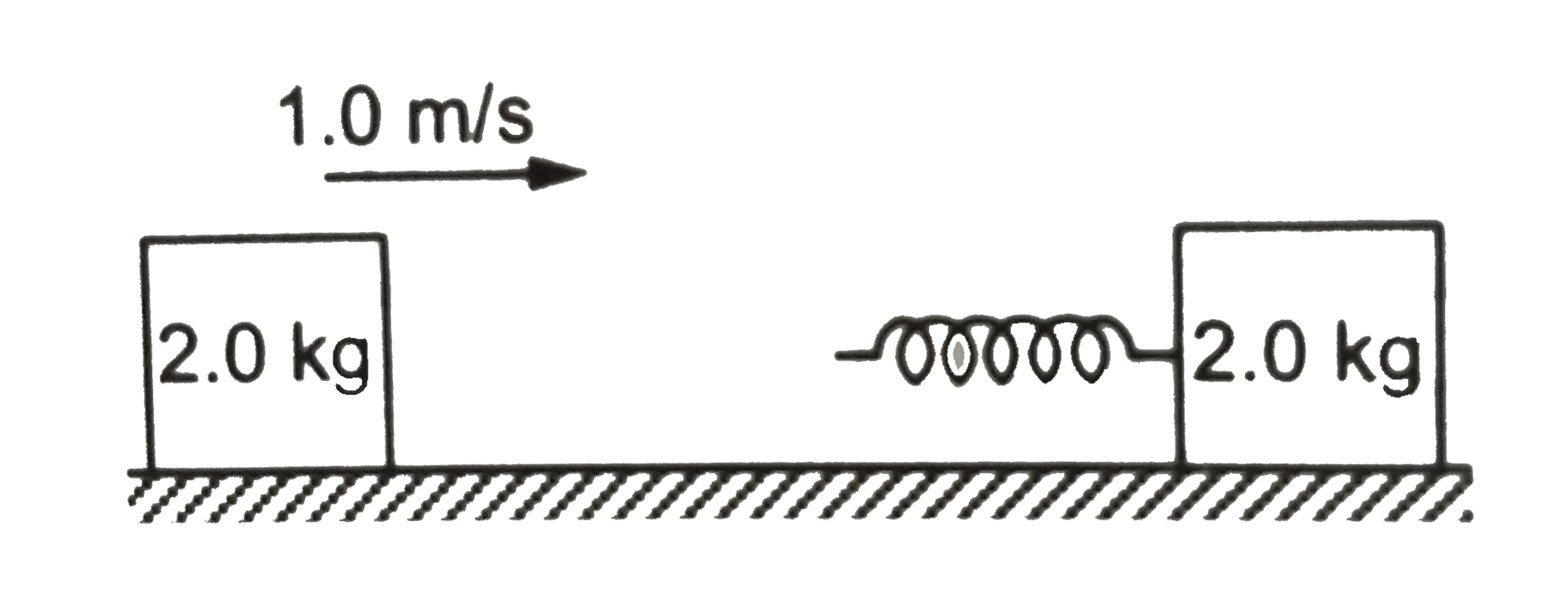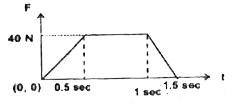A stream of water droplets, each of mass m = 0.001kg are fired horizontally at a velocity of towards a vertical steel plate where they collide. The droplets one spaced equidistant with a spacing of What is approximate average force exerted on the plate by the water droplets. (Assuming that they do not rebound after collision.)
10 N
100 N
1 N
To solve the problem, we need to calculate the average force exerted on the vertical steel plate by the stream of water droplets. Here’s a step-by-step breakdown of the solution:
Step 1: Calculate the change in momentum for one droplet
- Each droplet has a mass m=0.001kg and is moving with a velocity v=10m/s.
- The initial momentum of one droplet is given by:
pinitial=m⋅v=0.001kg×10m/s=0.01kg m/s
- After colliding with the plate, the droplet comes to rest, so its final momentum is:
pfinal=0kg m/s
- The change in momentum (Δp) for one droplet is:
Δp=pfinal−pinitial=0−0.01=−0.01kg m/s
- Since we are interested in the magnitude, we take:
|Δp|=0.01kg m/s
Step 2: Calculate the number of droplets hitting the plate per second
- The droplets are spaced 1 cm apart, which is equivalent to 0.01m.
- The velocity of the droplets is 10m/s.
- The distance covered by the droplets in 1 second is:
Distance=velocity×time=10m/s×1s=10m
- The number of droplets that will hit the plate in 1 second can be calculated as:
Number of droplets=DistanceSpacing=10m0.01m=1000
Step 3: Calculate the total change in momentum per second
- The total change in momentum per second (ΔP) is given by:
ΔP=Number of droplets×|Δp|=1000×0.01kg m/s=10kg m/s
Step 4: Calculate the average force exerted on the plate
- The average force (F) exerted on the plate is equal to the rate of change of momentum:
F=ΔP=10N
Thus, the approximate average force exerted on the plate by the water droplets is 10 N.
- Each droplet has a mass m=0.001kg and is moving with a velocity v=10m/s.
- The initial momentum of one droplet is given by:
pinitial=m⋅v=0.001kg×10m/s=0.01kg m/s
- After colliding with the plate, the droplet comes to rest, so its final momentum is:
pfinal=0kg m/s
- The change in momentum (Δp) for one droplet is:
Δp=pfinal−pinitial=0−0.01=−0.01kg m/s
- Since we are interested in the magnitude, we take:
|Δp|=0.01kg m/s
- The droplets are spaced 1 cm apart, which is equivalent to 0.01m.
- The velocity of the droplets is 10m/s.
- The distance covered by the droplets in 1 second is:
Distance=velocity×time=10m/s×1s=10m
- The number of droplets that will hit the plate in 1 second can be calculated as:
Number of droplets=DistanceSpacing=10m0.01m=1000
- The total change in momentum per second (ΔP) is given by:
ΔP=Number of droplets×|Δp|=1000×0.01kg m/s=10kg m/s
- The average force (F) exerted on the plate is equal to the rate of change of momentum:
F=ΔP=10N
Topper's Solved these Questions
- BOOK - DC PANDEY ENGLISHCHAPTER - CENTRE OF MASS, IMPULSE AND MOMENTUMEXERCISE - Only one option is correct for JEE Advanced60videos
CENTRE OF MASS, IMPULSE AND MOMENTUM
- BOOK - DC PANDEY ENGLISHCHAPTER - CENTRE OF MASS, IMPULSE AND MOMENTUMEXERCISE - More a than one option is Correct1videos
CENTRE OF MASS, IMPULSE AND MOMENTUM
- BOOK - DC PANDEY ENGLISHCHAPTER - CENTRE OF MASSEXERCISE - Medical entrances gallery27videos
CENTRE OF MASS
- BOOK - DC PANDEY ENGLISHCHAPTER - CENTRE OF MASS, LINEAR MOMENTUM AND COLLISIONEXERCISE - Level 2 Subjective21videos
CENTRE OF MASS, LINEAR MOMENTUM AND COLLISION
Similar Questions
A stream of water flowing horizontally with a speed of 15ms−1 pushes out of a tube of cross sectional area 10−2m2 and hits a vertical wall near by what is the force exerted on the wall by the impact of water assuming.that it does not rebound? (Density of water =1000kgm3)
View SolutionA flat plate moves normally towards a discharging jet of water at the rate of 3m/s. The jet discharges the water at the rate of 0.1m3/s and at the speed of 18m/s. The force exerted on the plate due to the jet is
View Solution
Knowledge Check
- Question 1 - Select One
A stream of water flowing horizontally with a speed of 15ms−1 pushes out of a tube of cross sectional area 10−2m2 and hits a vertical wall nearby. What is the force exerted on the wall by the impact of water assuming that it does not rebound? (Density of water =1000kgm−3)
A1.25×103NB2.25×103NC3.25×103ND4.25×103N - Question 2 - Select One
A stream of water flowing horizontally with a speed of 25ms−1 gushes out of a tube of cross-sectional area 10−3m2, and hits at a vertical wall nearby. What is the force exerted on the wall by the impact of water?
A125NB625NC−650ND−1125N
A block of mass 2.0 kg is moving on a frictionless horizontal surface with a velocity of 1.0 m/s figure towards another block of equal mass kept at rest. The spring constant of the spring fixed at one end is 100 N/m. Find the maximum compression of the spring.
 View Solution
View SolutionA rifle man, who together with his rifle has a mass of 100kg, stands on a smooth surface and fires 10 shots horizontally. Each bullet. has a mass 10g and a muzzle velocity of 800m/s,
a. What velocity does the rifle man acquire at the end of 10 shots?
b. If the shots are fired in 10s, what will he the average force exerted on him?
c. Compare his kinetic energy with that of 10 bulletsView SolutionAn object of mass 1 kg moving on a horizontal surface with initial velocity 8 m/s comes to rest after 10 s. If one wants to keep the object moving on the same surface with velocity 8 m/s the force required is
View SolutionA body of mass m = 4 kg moving with a velocity 10 m/s collides head - on with another object for 1.5 sec. The impulsive force versus time graph is shown during the collision of the body and object. Find the velocity of body after collision.
 View Solution
View SolutionA Rubber Ball Rebound
A rubber ball of mass 2.0kg falls to the floor. The ball hits with a speed of 8m/s and rebounds with approximately the same speed. High speed photographs show that the ball is in contact with the floor for 10^-3s. What can we say about the force exerted on the ball by the floor?
 View Solution
View SolutionA block of mass M=4kg is moving with velocity V=6m/s toward a target block of mass=2kg, which is stationary (v=0). The object collide heat-on, and immediately after the collision, the speed of block m is 4 times the speed of block M.
Q. What is the speed of block M after the collision?View Solution

